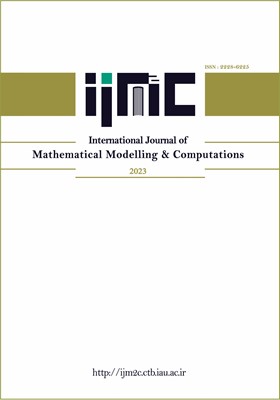Coronavirus (covid-19) Transmission Dynamics with Vaccination: A Mathematical Model Analysis
Subject Areas : International Journal of Mathematical Modelling & Computations
Mengesha Firdawoke
1
*
![]() ,
Mekash Mohammed
2
,
Mekash Mohammed
2
![]()
1 - Department of Mathematics, College of Natural and Computational Science, Samara university, Samara, Ethiopia.
2 - Department of Mathematics, College of Natural and Computational Science, Samara University, Samara, Ethiopia.
Keywords: Stability Analysis, equilibrium point, COVID-19, Reproduction Number, Pandemic,
Abstract :
In this paper, a nonlinear mathematical model of COVID-19 was developed. An SVEIHR model has been proposed using a system of ordinary differential equations. The model’s equilibrium points were found, and the model’s stability analysis and sensitivity analysis around these equilibrium points were investigated. The model’s basic reproduction number is investigated in the next-generation matrix. The disease free equilibrium of the COVID-19 model is stable if the basic reproduction number is less than unity; if the basic reproduction number is greater than unity, the disease free equilibrium is unstable. We also utilize numerical simulation to explain how each parameter affects the basic reproduction number.
[1] A. Assiri, J.A. Al-Tawfiq, A.A. Al-Rabeeah, F.A. Al-Rabiah, S. Al-Hajjar, A. Al-Barrak, H. Flemban,
W.N.AlNassir, H.H. Balkhy, R.F. Al-Hakeem, H.Q. Makhdoom, A.I. Zumla, Z.A. Memish, Epidemiological,
demographic, and clinical characteristics of 47 cases of Middle East respiratory syndrome coronavirus disease
from Saudi Arabia: a descriptive study, The Lancet infectious diseases 13(2013)752-761.
[2] A.M. Zaki, S. van Boheemen, T.M. Bestebroer, A.D.M.E. Osterhaus, R.A.M. Fouchier, Isolation of a novel
coronavirus from a man with pneumonia in Saudi Arabia, New England Journal of Medicine 367 (2012) 1814–
1820.
[3] A.Labzai, A.Kouidere, O.Balatif, & M.Rachik, Stability analysis of mathematical model new coronavirus
(COVID-19) disease spread in population, Commun. Math. Biol. Neurosci. 2020 (2020) Article-ID.
[4] Coronavirus, WHO Novel, Situation Report-51. 2020, Geneva, (2019).
[5] Covid, CDC and Team, Response and Covid, CDC and Team, Response and Bialek, Stephanie and Gierke,
Ryan and Hughes, Michelle and McNamara, Lucy A and Pilishvili, Tamara and Skoff, Tami, Coronavirus
disease 2019 in children United States, february 12–april 2, 2020, Morbidity and Mortality Weekly
Report,69(2020)422.
[6] H.S.Khoshnaw, H.R. Salih, & S.Sulaimany, Mathematical modelling for coronavirus disease (COVID-19) in
predicting future behaviours and sensitivity analysis, Mathematical Modelling of Natural Phenomena 15
(2020)33.
[7] M.SERHANI & H.Labbardi, Mathematical modeling of COVID-19 spreading with asymptomatic infected and
interacting peoples, Journal of Applied Mathematics and Computing,66(2020)1-20.
[8] M. Tahir, IS. Ali Shah, G. Zaman, T. Khan, prevention strategies for mathematical model MERS-corona virus
with stability analysis and optimal control, J Nanosci. Nanotechnol. Appl. 3 (2018), 101.
[9] N. Chintis, J. M. Hyman, and J. M. Cushing, Determining important parameters in the spread of malaria through
the sensitivity analysis of a mathematical model, Bulletin of mathematical biology 70(2008) 1272 - 1296.
[10] O.Victor, Alexander, Mathematical predictions for COVID-19 as a global pandemic, Available at SSRN
3555879(2020).
[11] P. Driessche, J. Watmough, Reproduction numbers and sub-threshold endemic equilibria for compartmental
models of disease transmission, Mathematical biosciences 180 (2002) 29-48.
[12] R.Ghostine, M.Gharamti, S.Hassrouny, & I. Hoteit, An extended SEIR model with vaccination for forecasting
the COVID-19 pandemic in Saudi Arabia using an ensemble Kalman filter, Mathematics 9(2021)636.
[13] S.Mwalili, M.Kimanthi, V.Ojiambo, D.Gathungu, & W.R.Mbogo, SEIR model for COVID-19 dynamics
incorporating the environment and social distancing, BMC Research Notes. 13(2020)1-5.
[14] T.H.Alemneh, & T.G.Telahun, Mathematical modeling and optimal control analysis of covid-19 in Ethiopia,
medRxiv (2020).
[15] World Health Organization and others, Modes of transmission of virus causing COVID-19: implications for
IPC precaution recommendations: scientific brief, 29 March 2020, World health Organization, (2020).
[16] C. Castillo-Chavez and B. Song Dynamical models of tuberculosis and their applications. Math. Biosci. Eng.
1(2004): 361-404

